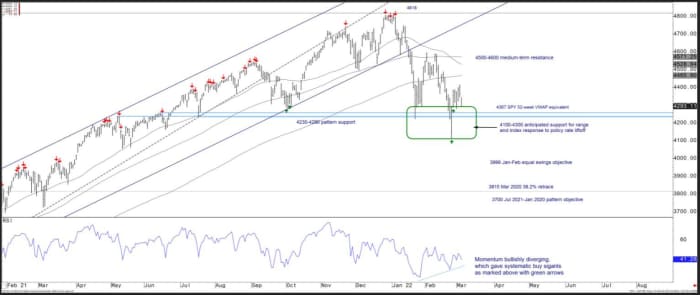This post was originally published on this site
Nearly two weeks into the Russia-Ukraine war, and with economic headwinds growing, Wall Street analysts were beginning to chip away at their S&P 500 expectations for this year.
A test of 3,670 on the main index
SPX,
can’t be ruled out, warned a team of strategists led by Julian Emanuel at Evercore ISI, in a note to clients on Sunday. Their actual downgrade was a less dramatic move to 4,800 from 5,100, but it came with several caveats.
“The uncertainty – European bank weakness, newly parabolic (wheat and oil) commodities, nuclear threats — has yet to fully ‘wash ashore’ to the U.S. But signs are emerging — incremental funding stress, ‘haven’ dollar strength, 10/2 curve flattening reflecting oil’s potential to dampen growth,” said Emanuel and the team, in a note to clients on Sunday.
“All this, set against a hiking Fed, will continue to weigh on stocks consistent with our blueprint for equity weakness into and after” the March 16 Fed policy meeting, they added.
The S&P 500 was poised for a weaker start on Monday, with futures down but off deeper lows triggered by spiking oil prices after Secretary of State Antony Blinken said U.S. and European officials were discussing a potential ban of Russian oil. Both U.S.
CL00,
and Brent crude
BRN00,
spiked to levels not seen since 2008 before paring back, but the entire commodity space was surging, with fresh records for wheat and palladium.
As of Friday’s close, the S&P 500 was down 9.75% from its record close of 4,796.56 reached Jan. 3, 2022, according to Dow Jones Market Data.
Read: Warren Buffett says never to hold money during a war. Here’s a stagflation playbook for stocks.
But Evercore advised that investors remain nimble, keeping exposures balanced until the “fog of war” abates some, noting that cash will depreciate in value through inflation. “Over 100 years of Bear and Bull markets, selling weakness has become a consistently unprofitable strategy, even when times become more uncertain,” said Emanuel and the team.
That move follows a similar downgrade from Citigroup strategists, who said late Friday that they are now expecting the S&P 500 will end 2022 at 4,700 versus their previous target of 5,100.
“We expect that a higher geopolitical risk premium will negatively impact broader market expected valuations. There is no change to our index-level earnings expectations,” wrote Citigroup analysts Scott Chronert and Drew Pettit in a note to clients on Friday. “Implicitly, we see upside to U.S. equities from here as the market narrative moves past the current perfect storm of headwinds, but to a level implying a flattish, to slightly down full-year return.”
Ed Yardeni, president of Yardeni Research told clients he was cutting his year-end 2022 and 2023 S&P 500 forecast targets to 4,000 and 5,000 respectively.
“For the U.S. economy, we now see stagflation, with persistently higher inflation and less economic growth than expected before the war. A recession can no longer be ruled out…for stock investors we think 2022 will continue to be one of this bull market’s toughest years,” he wrote.
Here’s a refresher on where nine Wall Street banks predicted the S&P 500 would end this year.
JP Morgan strategists, meanwhile, noted that the S&P 500 “has been able to hold above last week’s bullish reversal from the lower end of our 4100-4300 favored medium-term support zone despite significant pressure on European markets.
“We still maintain a base-case view that the area will hold; but, we recognize the nature of the headlines driving the market can quickly run over the technical setup,” said a team led by strategist Jason Hunter.

JPMorgan
Meanwhile, Montreal-based BCA told clients that while they were now attaching an “uncomfortably high 10% chance of a civilization-ending global nuclear war over the next 12 months,” investors were still better off betting on the future.


